Download and print as a PDF (753kB pdf)
On this page
You have been given this mask to use with your Non Invasive Ventilator.
Please never share masks between users.
How often should I care for my mask?
Care and hygiene of the mask is very important and must be completed daily. This is to ensure patient comfort and correct mask fitness. Application of mask is essential in achieving optimal overnight treatment of Non-Invasive Ventilation therapy.
How should I care for my mask?
1. Always take apart the mask components to clean it (see your mask user guide if you need instructions).
2. Observe mask seal for any degradation such as tears in the silicone. The seal should not feel floppy or stretched. The texture of the seal should not feel greasy or shiny. It should look cloudy and be slightly tacky to touch. This helps the mask to stick to the skin.
3. Please ensure the mask is washed daily in mild soapy water. Thoroughly hand wash the separated mask components (excluding headgear and soft sleeves) by gently rubbing in warm water (approximately 30°C / 86°F) with mild washing-up detergent. To optimise the mask seal, facial oils should be removed from the cushion after use. Use a soft bristle brush to clean the vent or any rotating parts on your mask such as the swivel, swivel ring or ball joint that require cleaning.
4. Inspect each component and, if required, repeat washing until it looks clean.
5. Rinse all the components well with clean water and allow to air dry. Do not dry in direct sunlight.
6. Please note: masks are not suitable for cleaning in a dishwasher or washing machine.
7. Reassemble your mask, when all components including the vent are dry (see your mask user guide if you need further instructions).
How should I care for the headgear?
8. Each week, handwash the headgear and wash in mild detergent and leave to air dry, including the soft sleeves if these form part of your mask. Rinse well, squeeze the headgear to remove excess water and allow to air dry out of direct sunlight.
9. Please check the headgear: there should be no frays at the edges or tears at the seams. Stitching should be intact, tight and not baggy. The Velcro should also stick together firmly and not come undone, lift or curl at the edges.
If there is any visible deterioration of any component (cracking, discolouration, tears, etc.), you should replace that component.
How should I put on my mask?
- Step 1. Ensure mask has all parts intact.
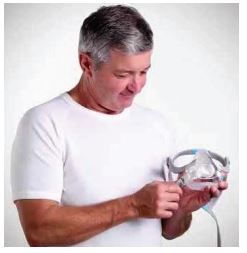
- Step 2. Place mask bottom section of seal onto chin crescent and bring mask up, so point of mask sits on bridge of nose. Back of headgear to sit nape of neck approximately collar line.
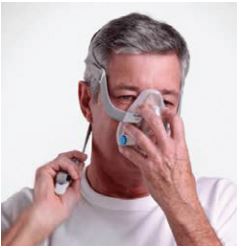
- Step 3. Once in place and whilst holding mask, tighten each side of mask top straps.
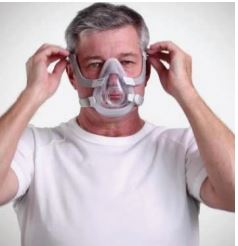
- Step 4. Proceed to tighten bottom straps. Please ensure not over tightened and two fingers slip comfortably underneath strap.
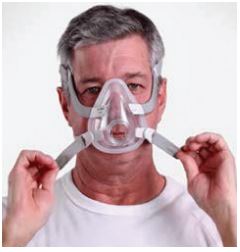
- Step 5. Connect mask elbow. A click will be heard.
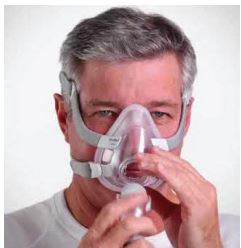
- Step 6. Connect hose.
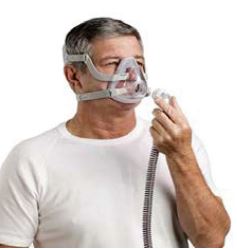
You are now ready to switch device on and start your treatment.
Contact Details
Home NIV Service
Royal Sussex County Hospital, Eastern Road, Brighton BN2 5BE
01273 696955
Ext. 64124 / 62941
This leaflet is intended for patients receiving care in Brighton and Hove or Haywards Heath.
University Hospitals Sussex NHS Foundation Trust Disclaimer: The information in this leaflet is for guidance purposes only and is in no way intended to replace professional clinical advice by a qualified practitioner.